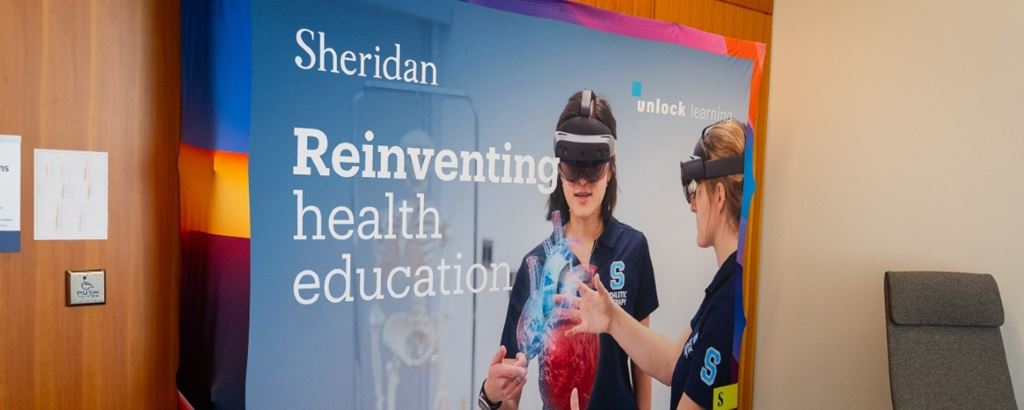
Sheridan healthcare symposium focuses on chronic-disease prevention, advances in technology
 by James Madge – Jul 18, 2025
by James Madge – Jul 18, 2025 More than 100 healthcare practitioners, members of industry, community members, and educators gathered at Sheridan College this spring to address the need for chronic disease prevention.
The groundbreaking symposium, Reimagining Healthcare: Innovative Approaches to Prevent Chronic Disease, marked Sheridan College’s first event of its kind and was particularly relevant given that millions in Ontario — including nearly half of Peel Region's population of 1.5 million — live with a chronic disease.
Talks throughout the day explored social and economic factors that influence health, as well as new approaches to education, technology, and leveraging research to support well-being across the lifespan. A significant theme throughout was the importance of interdisciplinary collaboration and co-creating solutions with community partners to create patient-centric, culturally responsive, and upstream healthcare approaches.
Dr. Michael O’Leary, Executive Dean of Sheridan’s Faculty of Health and Community Studies, highlighted the College’s dedication to advancing healthcare in his opening remarks.
“During the pandemic, we opened our doors to a transformative vaccine clinic that provided vaccines to those who most needed them at a time when access was an issue,” said O’Leary. “We've expanded our programs to ensure we have more nurses and healthcare professionals ready to provide care, not only in our hospitals but in the community, where they’re most needed. We are taking steps to introduce more programs in areas like diagnostic imaging, as the need for it grows in Ontario and the opportunity for diagnostic-imaging professionals expand.”
Social Determinants of Health
Throughout the day, numerous speakers reflected on the need to recognize that many of the factors that influence health are determined by the socio-economic realities that shape people’s lives. Vito Ciciretto, president and CEO of Dynacare, was the opening keynote speaker and emphasized the need to provide “healthcare, not sick care.”
“We need to think ahead and act now so we can save later,” said Ciciretto. “It's no secret that our fee-for-service system creates little incentive for preventative care. … Providers and payers must understand and accept that, in some cases, investing resources to deliver more care early on leads to better health outcomes later and lowers costs down the road.”

It was a sentiment shared by closing keynote speaker Dr. Lawrence Loh, who took the opportunity to emphasize that society, rather than just hospitals or clinics (the acute care system) is the "real health system." He likened acute care to a courtroom — a place you ideally want to avoid.
“At the end of the day, it really is the same adage of an ounce of prevention is better than a pound of cure,” said the former Medical Officer of Health who led the Region of Peel through the pandemic.
The day also featured a pair of panels, with the first one addressing the role public health plays in preventative, upstream healthcare.
“In a richly diverse region like Peel, public-health strategies require much more than translating a pamphlet or holding a one-off town hall,” said Angela Carter, advisor for Roots Community Services. “It means deeply understanding how culture, migration experiences, history and identity shape health, beliefs and behaviours.”
 Technology and partnerships
Technology and partnerships
Symposium attendees also heard how advances in technology like Artificial Intelligence (AI), as well as partnerships between industry and community partners and postsecondary institutions, can foster opportunities that can create real change to build healthy communities. The second panel discussed how AI could serve as possible game-changer for chronic-disease prevention.
“We're working on liquid biopsy that can detect disease way before it's detectable using current technology,” said Steve Schudlo, a Sheridan grad who now works as the Business Development Principal for AI, Data, and Digital at the University Hospital Network in Toronto. “So, if you look at what a detector does, they have vials of blood. There's way more information in that blood than they're utilizing. With AI and advanced DNA sequencing, you'll be able to start detecting diseases way sooner.”
Dr. Vicki Mowat, Sheridan’s Dean of Research at Generator, detailed how the College’s purpose-driven applied research “has contributed to projects that tackle real-world health challenges” in areas as diverse as elder care (a virtual person who can help detect cognitive decline in seniors) to prosthetics (a machine that learns how people walk so that a prosthetic can be designed to fit better and be less painful).
Symposium chair and Sheridan alumnus Michael Cloutier applauded the work being done in public-private collaboration, highlighting its essential nature and power for Canadian initiatives.

An example of that came via Adam Marsella of Novo Nordisk, who discussed the Cities for Better Health initiative, which his company launched in 2014 and now includes more than 50 cities around the world, including Mississauga.
“The program addresses childhood obesity and supports city-level partners to improve access to healthy food and safe places for physical activity,” said Marsella, explaining how one community in Denmark managed to buck the global trend by reducing the rates of childhood obesity by 10 per cent over a 10-year period.
“We can't treat our way out of chronic diseases,” said Marsella, “and we can't treat our way out of the chronic disease epidemic with medicine alone.”
Top photo, from left to right: Nancy Polsinelli, Commissioner of Health Services, Peel Region; Aderemi (Remi) Ejiwunmi, Shah Family Hospital for Women and Children; and Angela Carter, Roots Community Services.
Second photo, from left to right: Michelle Theroux, Deloitte; Kaushik Sripada, Hoffmann-La Roche Limited; and Steve Schudlo, University Health Network.
Bottom photo: Symposium chair and Sheridan alumnus Michael Cloutier.
Media Contact
For media inquiries, contact Sheridan’s Communications and Public Relations team.
